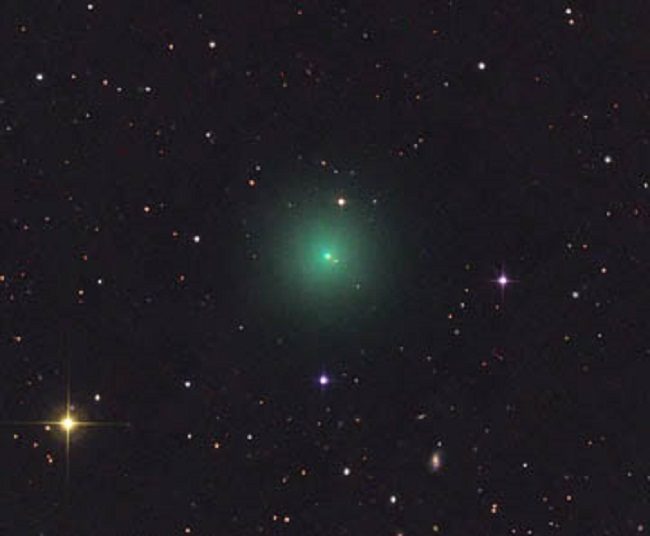
© Rolando LigustriNew Comet ASASSN1 (C/2017 O1) already glows aqua from carbon-laced gases. The comet is currently visible in the pre-dawn sky through modest-sized telescopes.
It feels like the FedEx guy just pulled up and dropped off a truckload of astronomical goodies. News arrived in my e-mail Monday about a new comet discovered by the
All-Sky Automated Survey for Supernovae (ASAS-SN).Founding member Benjamin Shappee and team have 498 bright supernovae and numerous other transient sources to their credit, but this is the group's
first comet discovery, ASASSN1 (C/2017 O1).
The 15th-magnitude object was
caught before dawn on July 19th in the constellation Cetus using data from the quadruple 14-cm "Cassius" telescope on Cerro Tololo, Chile. Don't be put off by that magnitude. The comet has brightened quickly in the past few days; visual observers are now reporting it at around magnitude +10 with a large (7′), weakly condensed coma. Chris Wyatt of Australia relates that a Swan band filter does a great job enhancing the apparent brightness and contrast of the coma, a sign this is a "gassy" comet.
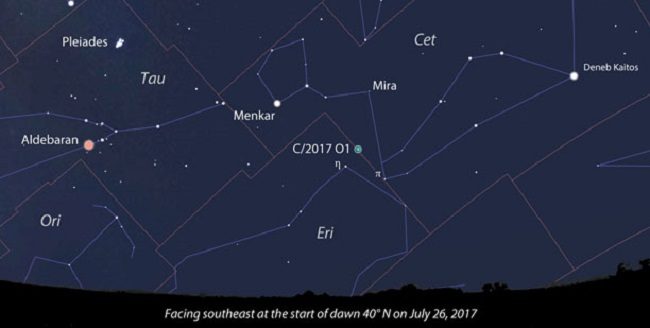
© StellariumThis wide-view map shows Comet ASASSN1's location at the Cetus–Eridanus border south of Alpha (α) Ceti (Menkar) on July 26th.
Assuming the orbit remains close to the current calculation, Comet ASASSN1 will move northeast across Cetus and Taurus this summer and fall, slowly brightening as it
approaches perihelion on October 14th in Perseus. It comes closest to the Earth four nights later, missing the planet by a cool 67 million miles. In a fun twist, ASASSN1 will slow down and spend the entire month of December and much of January within a few degrees of the North Star!
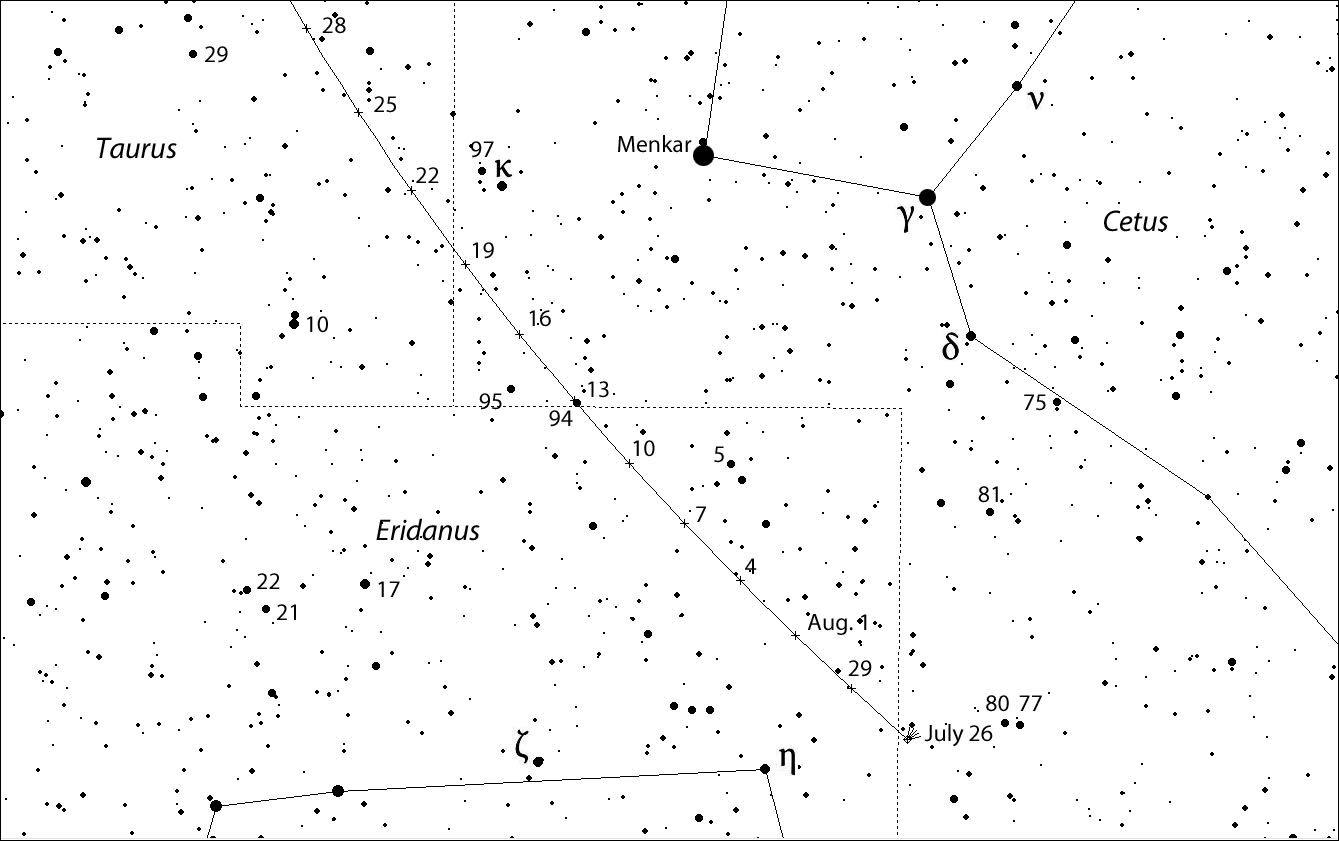
© Chris Marriott's SkyMapComet ASSASN1 (C/2017 O1) moves steadily to the northeast in the coming month, becoming higher and easier to see before dawn. Stars are shown to magnitude +9 and comet positions are marked every 3 days at ~4 a.m. CDT. North is up.
Still, don't count your comets before they hatch. Or even after. Hairy stars can be fickle. There's a fair chance we're only seeing a temporary bright outburst of an intrinsically faint comet. But who knows? You and I will have to keep track of it to find out. Right now, ASASSN1 stands about 20° high in the southeastern sky as it crosses from Cetus into Eridanus. An 8-inch telescope should have no problem bringing it to life, especially now that the Moon's out of view and won't return to the morning sky until August 6th. You can stay in touch with the latest developments on
Shappee's Twitter page.
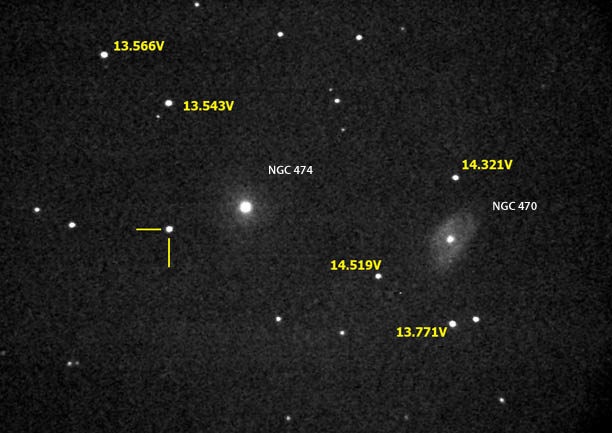
© Stan HowertonIn this photo from July 22nd, the new supernova SN 2017fgc shines at magnitude +13.7, far from the core of the elliptical galaxy NGC 474 in Pisces. You can use the comparison star magnitudes to estimate the supernova's brightness. North is up.
While you're out waiting for the comet to climb out of the haze, why not check out the
new supernova, SN 2017fgc, which recently exploded into view in the 11th-magnitude galaxy
NGC 474 in Pisces. At magnitude +13.7, you wouldn't call it "bright," but it's been rising since the
DLT40 Survey discovered it on July 11th. Based on spectra taken of the object, it was still a couple weeks before maximum in mid-July, so I wouldn't be surprised if it continues to brighten.
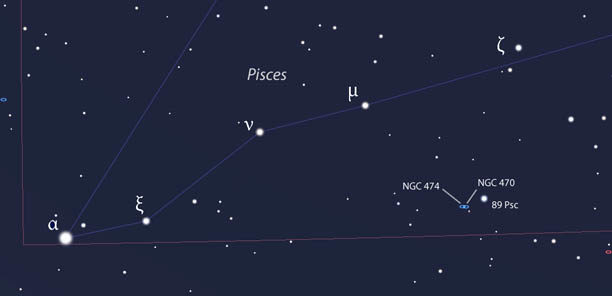
© StellariumThis wide-field chart will help get you to NGC 474. It shows stars to magnitude +8. Use the photo above to navigate to the supernova. North is up.
Lots of supernovae appear close to the nuclei of their host galaxies and are notoriously difficult to discern in the dense fuzz of unresolved starlight. Not this one. It's "in the clear" 116″ east and 45″ north of the galaxy's center, so you won't break an eyeball trying to see it. An 8-inch scope magnifying around 150×-200× should coax it into view on a dark, moonless morning.
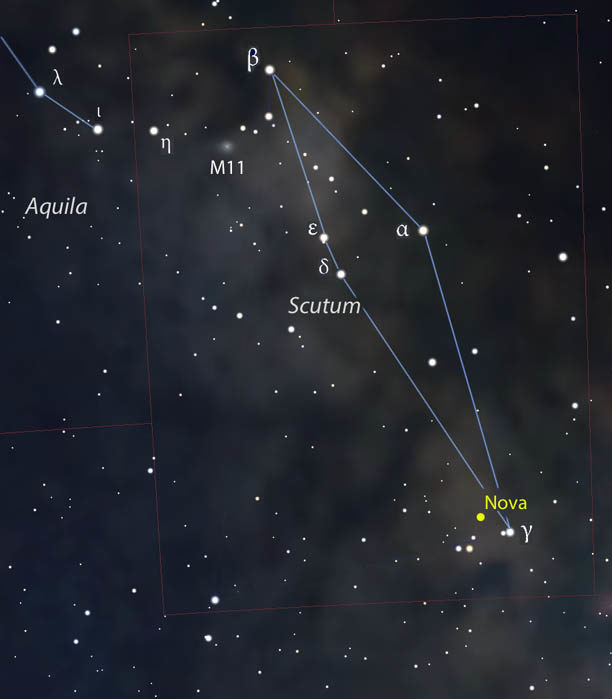
© StellariumUse this chart to find the nova, ASASSN17-hx. Then click, here and here for more detailed AAVSO charts you can use to pinpoint its position and estimate its brightness. When you bring this catastrophic pinpoint into focus, you'll be looking at what happens when a white dwarf star gains too much weight. After siphoning material from a close companion star for millennia, the dwarf exceeded its maximum weight of
1.4 solar masses and underwent a catastrophic gravitational collapse. The runaway fusion reaction that followed raced through the star, destroying it in one titanic blast. Overnight, a lowly white dwarf became a
Type Ia supernova, bright enough to see from 96 million light years, the distance to the host galaxy.
Finally, a
nova that's been dozing away at 12th-magnitude has started kicking out the jams! Since it's
discovery on June 23rd, ASASSN-17hx has brightened nearly two full magnitudes, putting it within range of large binoculars and small telescopes.
As you can tell from the object's name, the
ASAS-SN crew has been busy! Currently at about magnitude +9.5 (and still rising) in the Scutum Milky Way, it's well-placed for viewing at nightfall a few degrees below the tail of Aquila, the Eagle.
Like a Type Ia supernova, a nova occurs in a close binary star system where a normal star like our Sun is paired up with a white dwarf. Material pulled from the companion finds its way by way of accretion disk to the surface of the dwarf, where it accumulates, heats up, and ignites in a thermonuclear explosion. A sudden increase in brightness follows on the heels of the blast that raises the star from obscurity to binocular or even naked-eye visibility.
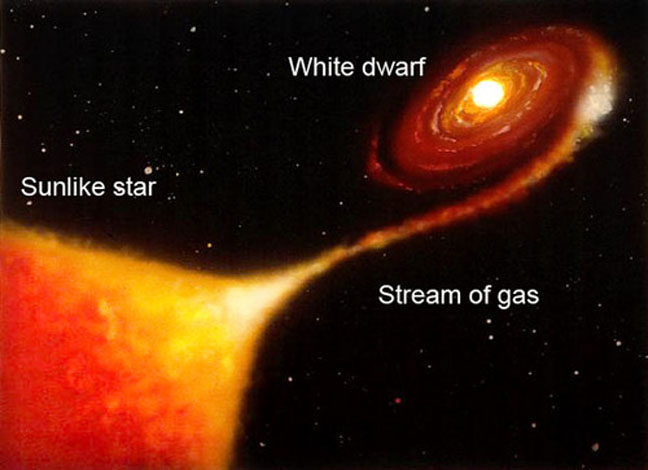
© NASANovae occur in close binary systems where one star is a tiny but extremely compact white dwarf star. The dwarf pulls material from its companion into a disk around itself; some of the adopted material funnels to the surface and ignites in a nova explosion.
Unlike a supernova, the dwarf in this system remains intact and the process begins anew. It's estimated that small white dwarfs have repeat nova outbursts about once every 5 million years; for larger dwarfs, it's about every 30,000 years. The most massive must take care as they teeter close to the 1.4-solar mass limit. If a dwarf doesn't burn and destroy the accumulated fuel in time, the extra mass can push it past the limit to supernova-dom.
Guess it's time to open up those packages. Clear skies!










Reader Comments
to our Newsletter